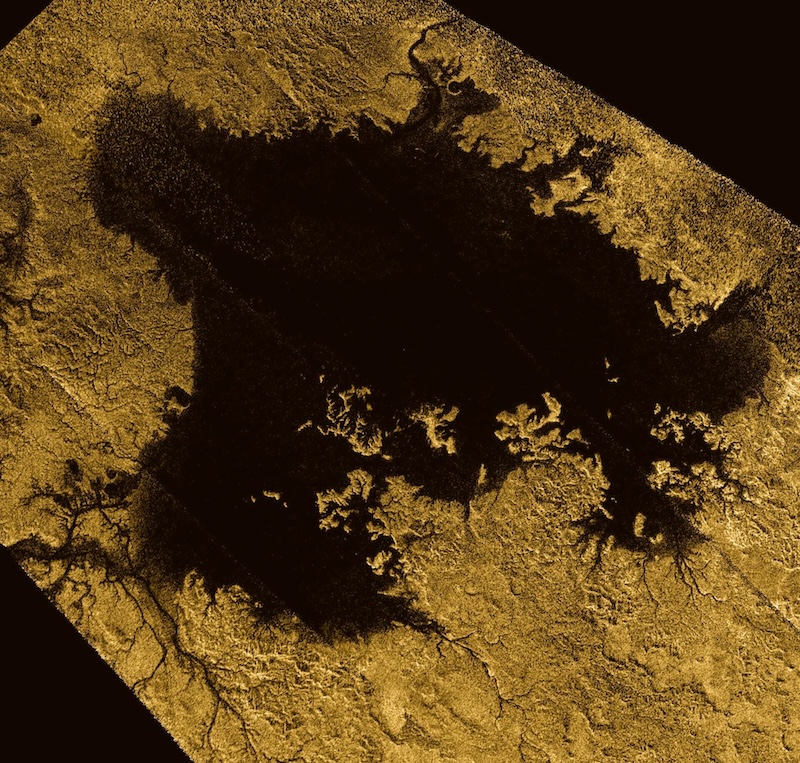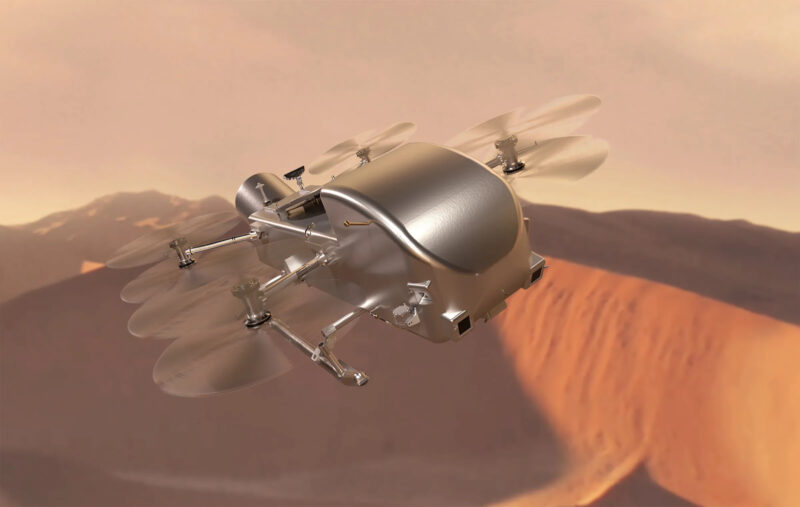
- Saturn’s large moon, Titan, has seas. The seas are liquid, but the liquid isn’t water. It’s methane and ethane.
- Researchers gained insight into the seas using radar data from the Cassini mission. They noted roughness and composition variations, and the seas’ reflectivity and surface waves.
- They found Titan’s seas behave in ways much like Earth’s water bodies, despite being made of methane and ethane. The researchers said they are influenced by similar meteorological processes and mixing dynamics.
Late last month, researchers said the methane/ethane seas of Saturn’s moon Titan – and smaller lakes on Titan – have waves that shape their shorelines. Now, another international team of researchers has learned more about Titan’s alien seas. Using radar data from NASA’s Cassini mission, the team said on July 16, 2024, that it has new findings about both the roughness and composition of Titan’s seas. One fascinating result: the rivers feeding into Titan’s seas mix methane and ethane, they said, in a way akin to freshwater rivers flowing into Earth’s saltwater oceans.
The researchers published the peer-reviewed results in Nature Communications on July 16, 2024.
Radar data from Cassini
Cassini’s mission at Saturn and its moons ended on September 15, 2017. But there is still tons of data for scientists to analyze, including radar data. Cassini used its radar to study Titan’s seas and lakes. Some of the radar data is monostatic. Monostatic radars use a single transmitter, receiver and antenna. For monostatic radars on Earth, both the transmitting and receiving antennas are close to each other in one radar station at the same location.
But Cassini also had bistatic radar, which is composed of multiple monostatic radars of the same frequency. On Earth, the transmitting and receiving antennas are placed apart from each other. In the case of Cassini, it aimed a radio beam from the spacecraft at Titan, which then reflects it toward the receiving antenna on Earth. That reflection is polarized. That means it provides information collected from two independent perspectives, instead of just one as with monostatic radar data. This makes it more useful than just using monostatic radar.
Lead author Valerio Poggiali in the Cornell Center for Astrophysics and Planetary Science (CCAPS) at Cornell University in Ithaca, New York, said:
The main difference is that the bistatic information is a more complete dataset, and is sensitive to both the composition of the reflecting surface and to its roughness.
Co-author Philip Nicholson, in the Department of Astronomy (A&S) at Cornell University added:
The successful execution of a bistatic radar experiment requires exquisite choreography between the scientists who design it, Cassini mission planners and navigators, and the team who collects the data at the receiving station.
Observing 3 largest seas on Titan
Cassini conducted three bistatic radar observations of Titan’s seas in 2014, on May 17, June 18 and October 24, and one in 2016, on November 14. It observed surface reflections from the radar as it neared Titan (ingress) and as it moved away again (egress).
Cassini observed the three largest seas on Titan: Kraken Mare, Ligeia Mare and Punga Mare.
Scientists have known that the seas, lakes, rivers and rain on Titan are composed of methane and/or ethane. The new analysis results refine this further.
The surface layers of the seas vary in composition, depending on location and latitude. With this in mind, the southernmost part of Kraken Mare had the highest dielectric constant. On Titan, that’s a measurement of the ability of the seas to reflect radio waves. The results showed that the seas and lakes are much less reflective than those composed of water on Earth. On Earth, water has a dielectric constant of about 80. But on Titan, it is typically only around 1.7.
In addition, the data provided more details about the waves. As detected by Cassini, surface waves were no more than 0.13 inches (3.3 mm) in height. They were slightly higher near coastlines, estuaries and interbasin straits, up to 0.2 inches (5 mm). This may indicate active tidal currents.

Titan’s seas behave much like those on Earth
There also differences in composition between the rivers and seas, with similarities to Earth. Poggiali said:
We also have indications that the rivers feeding the seas are pure methane, until they flow into the open liquid seas, which are more ethane-rich. It’s like on Earth, when freshwater rivers flow into and mix with the salty water of the oceans.
As Nicholson also noted:
This fits nicely with meteorological models for Titan, which predict that the ‘rain’ that falls from its skies is likely to be almost pure methane, but with trace amounts of ethane and other hydrocarbons.
Even with this new study, there is still much to learn about Titan’s seas. The data Cassini sent back to Earth will keep scientists busy for many years to come. Poggiali said:
There is a mine of data that still waits to be fully analyzed in ways that should yield more discoveries. This is only the first step.
NASA’s Dragonfly is the next major mission to Titan. Arriving in 2034, the large drone-like rotorcraft will fly to dozens of locations on Titan.
Bottom line: New analysis of radar data from Cassini shows that Titan’s seas and hydrological systems behave much like those on Earth despite the different compositions.
Read more: Shorelines of Titan’s seas likely shaped by waves
Read more: Ancient lake on Titan could have lasted thousands of years
The post Do Titan’s seas resemble earthly seas? Researchers say yes first appeared on EarthSky.
from EarthSky https://ift.tt/nK69I3M

- Saturn’s large moon, Titan, has seas. The seas are liquid, but the liquid isn’t water. It’s methane and ethane.
- Researchers gained insight into the seas using radar data from the Cassini mission. They noted roughness and composition variations, and the seas’ reflectivity and surface waves.
- They found Titan’s seas behave in ways much like Earth’s water bodies, despite being made of methane and ethane. The researchers said they are influenced by similar meteorological processes and mixing dynamics.
Late last month, researchers said the methane/ethane seas of Saturn’s moon Titan – and smaller lakes on Titan – have waves that shape their shorelines. Now, another international team of researchers has learned more about Titan’s alien seas. Using radar data from NASA’s Cassini mission, the team said on July 16, 2024, that it has new findings about both the roughness and composition of Titan’s seas. One fascinating result: the rivers feeding into Titan’s seas mix methane and ethane, they said, in a way akin to freshwater rivers flowing into Earth’s saltwater oceans.
The researchers published the peer-reviewed results in Nature Communications on July 16, 2024.
Radar data from Cassini
Cassini’s mission at Saturn and its moons ended on September 15, 2017. But there is still tons of data for scientists to analyze, including radar data. Cassini used its radar to study Titan’s seas and lakes. Some of the radar data is monostatic. Monostatic radars use a single transmitter, receiver and antenna. For monostatic radars on Earth, both the transmitting and receiving antennas are close to each other in one radar station at the same location.
But Cassini also had bistatic radar, which is composed of multiple monostatic radars of the same frequency. On Earth, the transmitting and receiving antennas are placed apart from each other. In the case of Cassini, it aimed a radio beam from the spacecraft at Titan, which then reflects it toward the receiving antenna on Earth. That reflection is polarized. That means it provides information collected from two independent perspectives, instead of just one as with monostatic radar data. This makes it more useful than just using monostatic radar.
Lead author Valerio Poggiali in the Cornell Center for Astrophysics and Planetary Science (CCAPS) at Cornell University in Ithaca, New York, said:
The main difference is that the bistatic information is a more complete dataset, and is sensitive to both the composition of the reflecting surface and to its roughness.
Co-author Philip Nicholson, in the Department of Astronomy (A&S) at Cornell University added:
The successful execution of a bistatic radar experiment requires exquisite choreography between the scientists who design it, Cassini mission planners and navigators, and the team who collects the data at the receiving station.
Observing 3 largest seas on Titan
Cassini conducted three bistatic radar observations of Titan’s seas in 2014, on May 17, June 18 and October 24, and one in 2016, on November 14. It observed surface reflections from the radar as it neared Titan (ingress) and as it moved away again (egress).
Cassini observed the three largest seas on Titan: Kraken Mare, Ligeia Mare and Punga Mare.
Scientists have known that the seas, lakes, rivers and rain on Titan are composed of methane and/or ethane. The new analysis results refine this further.
The surface layers of the seas vary in composition, depending on location and latitude. With this in mind, the southernmost part of Kraken Mare had the highest dielectric constant. On Titan, that’s a measurement of the ability of the seas to reflect radio waves. The results showed that the seas and lakes are much less reflective than those composed of water on Earth. On Earth, water has a dielectric constant of about 80. But on Titan, it is typically only around 1.7.
In addition, the data provided more details about the waves. As detected by Cassini, surface waves were no more than 0.13 inches (3.3 mm) in height. They were slightly higher near coastlines, estuaries and interbasin straits, up to 0.2 inches (5 mm). This may indicate active tidal currents.

Titan’s seas behave much like those on Earth
There also differences in composition between the rivers and seas, with similarities to Earth. Poggiali said:
We also have indications that the rivers feeding the seas are pure methane, until they flow into the open liquid seas, which are more ethane-rich. It’s like on Earth, when freshwater rivers flow into and mix with the salty water of the oceans.
As Nicholson also noted:
This fits nicely with meteorological models for Titan, which predict that the ‘rain’ that falls from its skies is likely to be almost pure methane, but with trace amounts of ethane and other hydrocarbons.
Even with this new study, there is still much to learn about Titan’s seas. The data Cassini sent back to Earth will keep scientists busy for many years to come. Poggiali said:
There is a mine of data that still waits to be fully analyzed in ways that should yield more discoveries. This is only the first step.
NASA’s Dragonfly is the next major mission to Titan. Arriving in 2034, the large drone-like rotorcraft will fly to dozens of locations on Titan.
Bottom line: New analysis of radar data from Cassini shows that Titan’s seas and hydrological systems behave much like those on Earth despite the different compositions.
Read more: Shorelines of Titan’s seas likely shaped by waves
Read more: Ancient lake on Titan could have lasted thousands of years
The post Do Titan’s seas resemble earthly seas? Researchers say yes first appeared on EarthSky.
from EarthSky https://ift.tt/nK69I3M

Aucun commentaire:
Enregistrer un commentaire